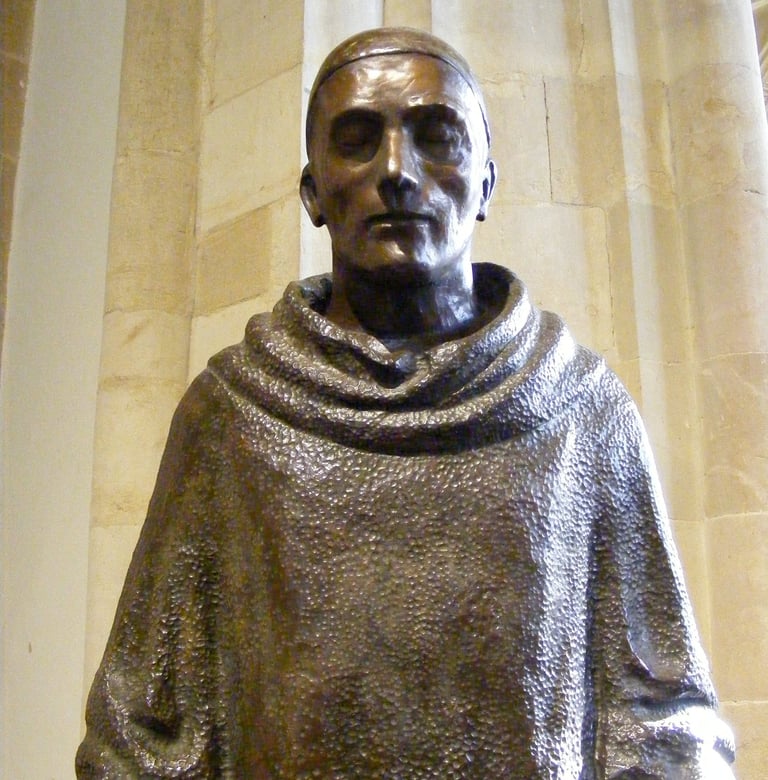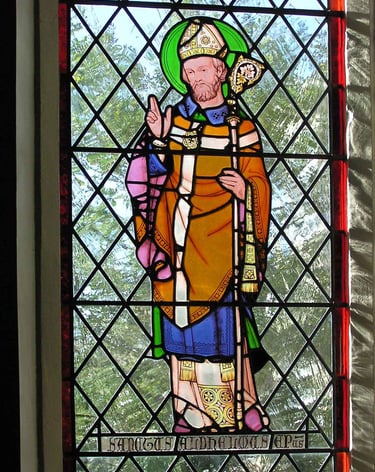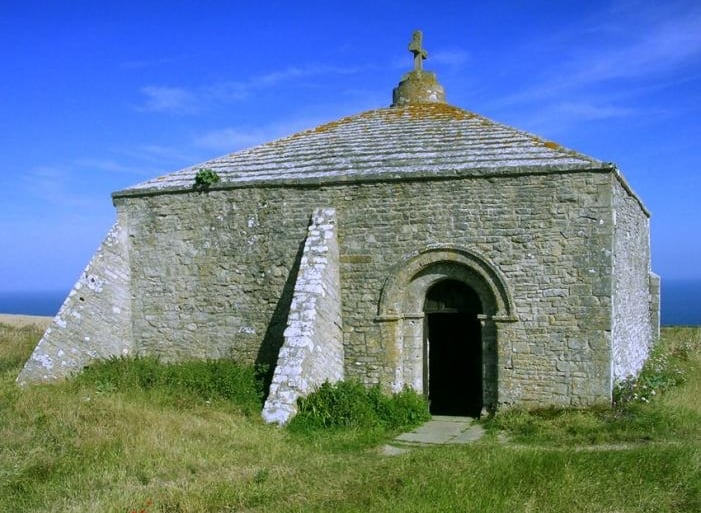St Aldhelm: Dorset riddler-saint
ST ALDHELM'S CHAPELSAINT ALDHELM
5/27/20245 min read


Statue of St Aldhelm in Sherborne Abbey. Source: Wikimedia commons.
Saint Aldhelm was commemorated in the Anglican church calendar this past weekend (May 25). Unfortunately, he has to share the day with the Venerable Bede who tends to get all the attention (and a ‘lesser festival’). Ironic, since Bede gives him great praise* in his History of the English Church and People.
Aldhelm is remembered on the day of his death, 709 AD, as Bishop of Sherborne, Dorset, and Abbot of Malmesbury, Wiltshire. Sources don’t agree on all the exact details of his life, and of course the anecdotes vary in plausibility, so take this as a hagiography of my favourite ‘facts’ and explore some of the sources below if you want to look further!
Aldhelm was born in the kingdom of Wessex in 639 and was a close relative (perhaps nephew or cousin) of King Ine and other rulers of Wessex. The conversion of the kingdom was taking place in this period, so Aldhelm was part of the the first generation to grow up in Christian Wessex.
He spent his formative years studying in Canterbury and going back and forth between Canterbury and Wessex, becoming renowned for his learning. During this time, he was part of an existing holy community in Selwood forest, Wiltshire, centred around the hermit Maeldub (who gives us the name Malmesbury), although another source says it was Aldhelm himself whose erudition drew monks and scholars to the place and he was their acknowledged leader. Whatever the exact truth, the group formalised as a monastery under Benedictine rule, with Aldhelm as their abbot, by around 680. The abbey flourished as a seat of learning and piety, with Aldhelm founding several other houses in the district, such as at Frome. Under Aldhelm, and into the Middle Ages, Malmesbury became one of the greatest monasteries in the country, with a substantial library.


Window in Malmesbury Abbey, 1928. Source: Wikimedia Commons
As a scholar, Aldhelm was said to be the most learned man in western medieval Europe before Bede came along. He was also a teacher who founded many schools, as well as a writer, poet, singer, and builder of churches. His piety apparently included the popular Celtic tradition of standing in freezing water reciting the Psalms.
One of his best known works is De Laude Virginitatis (In Praise of Virginity), written for the nuns at Barking Monastery where his relative, Cuthburga, resided. Since she later founded a great double monastery at Wimborne, Dorset and was canonised herself, the advice must have worked. King Alfred the Great later wrote of him as one of the most notable vernacular poets of Britain. Unfortunately, his Old English poems are lost. On a lighter note, he also composed a book of 100 riddles for King Aldfrith of Wessex in rather clever Latin verse – here’s one in translation.
No one can hold me in his palms or sight;
I scatter sudden clatter far and wide.
I want to hammer oaks with mournful might;
Yes, I strike sky and scour the countryside.**
Being a poet in those days also implied musical skills, and writers attest he could play the instruments of his day – the harp, fiddle and pipes. One source claims that he even designed an organ. King Alfred also records an anecdote that Aldhelm, observing that the peasants preferred to be running about town and gossiping rather than attend church, took up position on the town bridge and played as a minstrel. When he gathered an audience, he gradually introduced more serious themes, singing his own English translations of the Psalms, and winning the townsmen back to a more pious life.


St Aldhelm's Chapel, Worth Matravers. Source: Wikimedia Commons
Saints have to have miracle stories, of course, and here’s one to wet your appetite. On a sojourn to Rome, the Pope presented Aldhelm with a marble slab for an altar. A camel carried it across the Alps, but collapsed under the strain, smashing the slab. Aldhelm prayed for the restoration of both the slab and the camel, and both were healed. One tradition says that the slab of marble now lies inside the altar at Bruton church, Somerset; history doesn’t tell what became of the camel.
In his latter life, Aldhelm continued to be extremely active, visiting Rome, being part of the negotiations in the fallout of the Synod of Whitby (where it was agreed that Britain should confirm to the Roman, not Celtic, church), preaching to the royal household at Corfe Castle, church building, including at Langton Matravers and, of course, St Aldhelm’s head, and establishing a nunnery at Wareham. Another popular story goes that he once preached for hours to an entranced audience, and his staff, which he had stuck into the ground, sprouted into a tree – the place became known as Bishop’s Tree (now Bishopstrow).
In 705, the huge diocese of Wessex was split, and the diocese of Sherbourne created. Aldhelm reluctantly agreed to became Bishop of Sherborne, and continued to spread his mission throughout Wiltshire, Dorset, and Somerset, where he died while travelling. His body was carried back in state to be buried at Sherborne, with crosses erected along the way at resting points (unfortunately only a few fragments remained in various churches). He was buried at Malmesbury Abbey, but his relics were later transferred to Canterbury.
There are Dorset churches dedicated to St Aldhelm at Poole, Radipole, , Lytchett Heath, Boveridge, Belchalwell, and Worth Matravers (St Aldhelm’s head – see my post on this fascinating cliff top chapel). He has a statue at the front of Salisbury Cathedral and at Sherborne Abbey and is usually represented in art as holding a harp or a sprouting staff.
THE ST. ALDHELM PRAYER
God of mission,
You called Aldhelm to sing of Your love; May our hearts dance with joy,
Our lives tell Your story
And our wills be stirred
To walk with Your people on the Way,
Till we come to the feast of Your Kingdom; Through Jesus Christ, our Lord.
Amen.
*Disclaimer: Bede lavishly praises anyone who agrees with him on the timing of Easter controversy!
**The wind


Flag of St Aldhelm. Source: Wikimedia Commons
